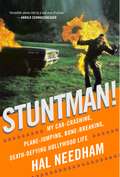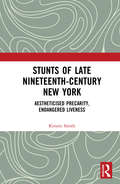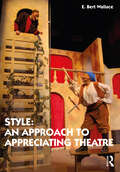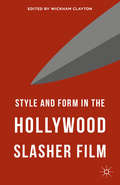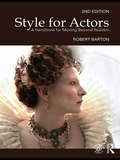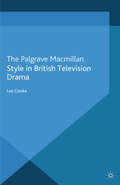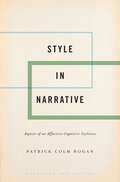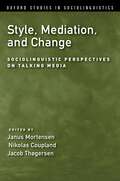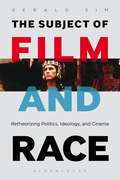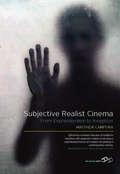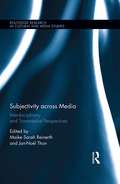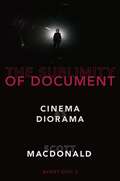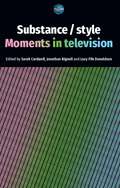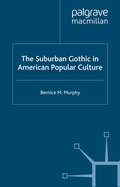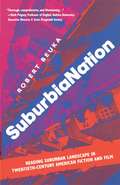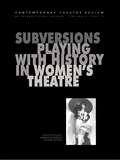- Table View
- List View
Stuntman!: My Car-Crashing, Plane-Jumping, Bone-Breaking, Death-Defying Hollywood Life
by Hal NeedhamYep that's me, Hal Needham, on the cover doing a fire stunt. When you're on fire you don't dare breathe because if you do, you'll suck those flames right down your throat. I was Hollywood's highest paid stuntman so I should know. I wrecked hundreds of cars, fell from tall buildings, got blown up, was dragged by horses, and along the way broke 56 bones, my back twice, punctured a lung and knocked out a few teeth...I hung upside down by my ankles under a bi-plane in The Spirit of St. Louis, jumped between galloping horses in Little Big Man, set a world record for a boat stunt on Gator, jumped a rocket powered pick-up truck across a canal for a GM commercial, was the first human to test the car airbag-and taught John Wayne how to really throw a movie punch. Life also got exciting outside of the movie business. I had my Ferrari stolen right from under my nose, flew in a twin-engine Cessna with a passed out pilot, rescued the cast and crew from a Russian invasion in Czechoslovakia, and once took six flight attendants on a date. I owned the Skoal-Bandit NASCAR race team, the sound-barrier breaking Budweiser Rocket Car and drove a souped-up, fake ambulance in a "little" cross-country race called The Cannonball Run, which became the movie I directed by the same name. Oh yeah, I also directed Smokey and the Bandit, Hooper and several other action/comedy movies that I liked a bunch. I was a sharecropper's son from the hills of Arkansas who became a Hollywood stuntman. That journey was a tough row to hoe. I continually risked my life but that was the career I chose. I was never late to the set and did whatever I had to do to get the job done. Hollywood's not all sunglasses and autographs. Let me tell you a few stories...
Stunts of Late Nineteenth-Century New York: Aestheticised Precarity, Endangered Liveness
by Kirstin SmithStunts of Late Nineteenth- Century New York: Aestheticised Precarity, Endangered Liveness examines the emergence of stunts in the media, politics, sport and art of New York at the turn of the twentieth century. This book investigates stunts in sport, media and politics, demonstrating how these risky performances tapped into anxieties and fantasies concerning work, freedom, gendered/ raced/ classed bodies and the commodifi cation of human life. Its case studies examine bridge jumping, extreme walking contests, stunt journalists such as Nellie Bly, and cycling feats including Annie Londonderry’s round- the- world venture. Supported by extensive archival research and Performance Studies theorisations of precarity, liveness and surrogation, Smith theorises an under- examined form which is still prevalent in art, politics and commerce, to show what stunts reveal about value, risk and human life. Suitable for scholars and practitioners across a range of subjects, from Performance Studies to gender studies, to media studies, Stunts of Late Nineteenth- Century New York explores how stunts turned everyday precarity into a spectacle.
Stunts of Late Nineteenth-Century New York: Aestheticised Precarity, Endangered Liveness
by Kirstin SmithStunts of Late Nineteenth- Century New York: Aestheticised Precarity, Endangered Liveness examines the emergence of stunts in the media, politics, sport and art of New York at the turn of the twentieth century. This book investigates stunts in sport, media and politics, demonstrating how these risky performances tapped into anxieties and fantasies concerning work, freedom, gendered/ raced/ classed bodies and the commodifi cation of human life. Its case studies examine bridge jumping, extreme walking contests, stunt journalists such as Nellie Bly, and cycling feats including Annie Londonderry’s round- the- world venture. Supported by extensive archival research and Performance Studies theorisations of precarity, liveness and surrogation, Smith theorises an under- examined form which is still prevalent in art, politics and commerce, to show what stunts reveal about value, risk and human life. Suitable for scholars and practitioners across a range of subjects, from Performance Studies to gender studies, to media studies, Stunts of Late Nineteenth- Century New York explores how stunts turned everyday precarity into a spectacle.
Style: An Approach To Appreciating Theatre
by E. Bert WallaceStyle: An Approach to Appreciating Theatre offers brief, readable chapters about the basics of theatre as a starting point for discussion, and provides new adaptations of classic plays that are both accessible to students learning about theatre and fit for production. In this text, style is the word used to describe the various ways in which theatre is done in real space and time by humans in the physical presence of other humans. The book uses style, the "liveness" of theatre that makes it distinct from literature or history, as a lens to see how playwrights, directors, designers, and actors bring scripts to life on stage. Rather than focusing on theatre history or literary script analysis, it emphasizes actual theatrical production through examples and explores playscripts illustrating four theatrical styles: Realism, Theatricalism, Expressionism, and Classicism. Susan Glaspells Realistic play Trifles is presented as written, while The Insect Play by the Brothers apek, The Hairy Ape by Eugene ONeill, and Antigone by Sophocles are original, full-length adaptions. Style: An Approach to Appreciating Theatre is the perfect resource for students of Theatre Appreciation, Introduction to Theatre, Theatrical Design, and Stagecraft courses.
Style and Form in the Hollywood Slasher Film
by Wickham ClaytonStyle and Form in the Hollywood Slasher Film fills a broad scholastic gap by analysing the elements of narrative and stylistic construction of films in the slasher subgenre of horror that have been produced and/or distributed in the Hollywood studio system from its initial boom in the late 1970s to the present.
Style: An Approach to Appreciating Theatre
by E. Bert WallaceStyle: An Approach to Appreciating Theatre offers brief, readable chapters about the basics of theatre as a starting point for discussion, and provides new adaptations of classic plays that are both accessible to students learning about theatre and fit for production. In this text, style is the word used to describe the various ways in which theatre is done in real space and time by humans in the physical presence of other humans. The book uses style, the "liveness" of theatre that makes it distinct from literature or history, as a lens to see how playwrights, directors, designers, and actors bring scripts to life on stage. Rather than focusing on theatre history or literary script analysis, it emphasizes actual theatrical production through examples and explores playscripts illustrating four theatrical styles: Realism, Theatricalism, Expressionism, and Classicism. Susan Glaspells Realistic play Trifles is presented as written, while The Insect Play by the Brothers apek, The Hairy Ape by Eugene ONeill, and Antigone by Sophocles are original, full-length adaptions. Style: An Approach to Appreciating Theatre is the perfect resource for students of Theatre Appreciation, Introduction to Theatre, Theatrical Design, and Stagecraft courses.
Style For Actors: A Handbook for Moving Beyond Realism
by Robert Barton"Style is a journey from tourist to native. It is living in the world of the play, not just visiting it." - from Chapter One Anyone who has ever struggled with capes, fans, swords, doublets and crinolines should make Style for Actors 2nd Edition their constant companion. Robert Barton has completely updated his award winning handbook for the 21st century with contemporary references and up-to-date illustrations. This is the definitive guide to roles in historical drama. The past is a foreign country, and this outstanding book is concerned with exploring it from the actor’s point of view. Specific guides range from Greek, Elizabethan, Restoration and Georgian theatre to more contemporary stylings, including Futurism, Surrealism and Postmodernism. Barton takes great care to present the actor with the roles and genres that will most commonly confront them. His analysis moves from entire genres to specific scenes and characters. A huge resource of nearly 150 practical exercises helps a newfound understanding of style to make the leap from page to performance.
Style For Actors 2nd Edition: A Handbook for Moving Beyond Realism
by Robert Barton"Style is a journey from tourist to native. It is living in the world of the play, not just visiting it." - from Chapter One Anyone who has ever struggled with capes, fans, swords, doublets and crinolines should make Style for Actors 2nd Edition their constant companion. Robert Barton has completely updated his award winning handbook for the 21st century with contemporary references and up-to-date illustrations. This is the definitive guide to roles in historical drama. The past is a foreign country, and this outstanding book is concerned with exploring it from the actor’s point of view. Specific guides range from Greek, Elizabethan, Restoration and Georgian theatre to more contemporary stylings, including Futurism, Surrealism and Postmodernism. Barton takes great care to present the actor with the roles and genres that will most commonly confront them. His analysis moves from entire genres to specific scenes and characters. A huge resource of nearly 150 practical exercises helps a newfound understanding of style to make the leap from page to performance.
Style in British Television Drama (Palgrave Close Readings in Film and Television)
by L. CookeThis pioneering book provides detailed analysis of scenes from nine British television dramas produced between 1954 and 2001. Taking dinner table scenes as a recurring motif, the study analyses changes in televisual style with reference to production practices, technology, aesthetic preferences, and social and institutional change.
Style in Narrative: Aspects of an Affective-Cognitive Stylistics (Cognition and Poetics)
by Patrick Colm HoganLiterary style is something many people talk about, but few could define. Yet it is crucial for our response to narrative art. Style can facilitate or obscure the events of a story or the motivations of a character, enhance the aesthetic appeal of a narrative or complicate its emotional impact, and even inflect the political or ethical implications of a work. It is precisely this complex operation of style that Patrick Colm Hogan explains in Style in Narrative. Drawing on recent psychological research, this book proposes a new and clear definition of style and provides a systematic theoretical account of style in relation to cognitive and affective science. Hogan's definition stresses that style varies by both scope, or the range of text or texts that may share a style, and level, the components of an individual work that might involve a shared style. The book uses rich examples from literature, film, and graphic fiction, including analysis of Virginia Woolf's Mrs. Dalloway, Shakespeare's canon, William Faulkner's As I Lay Dying, and Art Spiegelman's Maus, as well as visual analysis of films by Robert Rodriguez, Deepa Mehta, Eric Rohmer, M.F.Husain, Yasujiro Ozu, and Chuan Lu. Through these studies Hogan identifies stylistic concerns common across mediums as well as the most consequential stylistic differences between them. Bringing together three often separated mediums within a coherent framework, Style in Narrative makes an important contribution to and necessary intervention in the field of stylistics.
Style in Narrative: Aspects of an Affective-Cognitive Stylistics (Cognition and Poetics)
by Patrick Colm HoganLiterary style is something many people talk about, but few could define. Yet it is crucial for our response to narrative art. Style can facilitate or obscure the events of a story or the motivations of a character, enhance the aesthetic appeal of a narrative or complicate its emotional impact, and even inflect the political or ethical implications of a work. It is precisely this complex operation of style that Patrick Colm Hogan explains in Style in Narrative. Drawing on recent psychological research, this book proposes a new and clear definition of style and provides a systematic theoretical account of style in relation to cognitive and affective science. Hogan's definition stresses that style varies by both scope, or the range of text or texts that may share a style, and level, the components of an individual work that might involve a shared style. The book uses rich examples from literature, film, and graphic fiction, including analysis of Virginia Woolf's Mrs. Dalloway, Shakespeare's canon, William Faulkner's As I Lay Dying, and Art Spiegelman's Maus, as well as visual analysis of films by Robert Rodriguez, Deepa Mehta, Eric Rohmer, M.F.Husain, Yasujiro Ozu, and Chuan Lu. Through these studies Hogan identifies stylistic concerns common across mediums as well as the most consequential stylistic differences between them. Bringing together three often separated mediums within a coherent framework, Style in Narrative makes an important contribution to and necessary intervention in the field of stylistics.
Style, Mediation, and Change: Sociolinguistic Perspectives on Talking Media (Oxford Studies in Sociolinguistics)
by Janus Mortensen Nikolas Coupland Jacob ThogersenTechnologically mediated talk is organized around familiar styles-styles of person, relationship and genre. But media also consistently remake and re-style these familiar patterns. This book brings together original research on media styling in different national contexts and languages, written by authors at the forefront of sociolinguistic research on mediated talk. It highlights and theorizes how creative acts of mediated styling can promote social and sociolinguistic change. The globalized world is already massively mediatized-what we know about language, people and society is necessarily shaped through our engagement with media. But talking media are caught up in wider currents of rapid change too. Creative innovations in media styling can heighten reflexive awareness, but they can also unsettle existing understandings of language-society relations. In reporting new investigations by expert researchers this book gives an original and timely account of how style, media and change need to be integrated further to advance the discipline of sociolinguistics.
STYLE, MEDIATION & CHANGE OSSL C: Sociolinguistic Perspectives on Talking Media (Oxford Studies in Sociolinguistics)
by Janus Mortensen, Nikolas Coupland and Jacob ThogersenTechnologically mediated talk is organized around familiar styles-styles of person, relationship and genre. But media also consistently remake and re-style these familiar patterns. This book brings together original research on media styling in different national contexts and languages, written by authors at the forefront of sociolinguistic research on mediated talk. It highlights and theorizes how creative acts of mediated styling can promote social and sociolinguistic change. The globalized world is already massively mediatized-what we know about language, people and society is necessarily shaped through our engagement with media. But talking media are caught up in wider currents of rapid change too. Creative innovations in media styling can heighten reflexive awareness, but they can also unsettle existing understandings of language-society relations. In reporting new investigations by expert researchers this book gives an original and timely account of how style, media and change need to be integrated further to advance the discipline of sociolinguistics.
The Subject of Film and Race: Retheorizing Politics, Ideology, and Cinema
by Gerald SimThe Subject of Film and Race is the first comprehensive intervention into how film critics and scholars have sought to understand cinema's relationship to racial ideology. In attempting to do more than merely identify harmful stereotypes, research on 'films and race' appropriates ideas from post-structuralist theory. But on those platforms, the field takes intellectual and political positions that place its anti-racist efforts at an impasse. While presenting theoretical ideas in an accessible way, Gerald Sim's historical materialist approach uniquely triangulates well-known work by Edward Said with the Neo-Marxian writing about film by Theodor Adorno and Fredric Jameson. The Subject of Film and Race takes on topics such as identity politics, multiculturalism, multiracial discourse, and cyborg theory, to force film and media studies into rethinking their approach, specifically towards humanism and critical subjectivity. The book illustrates theoretical discussions with a diverse set of familiar films by John Ford, Michael Mann, Todd Solondz, Quentin Tarantino, Keanu Reeves, and others, to show that we must always be aware of capitalist history when thinking about race, ethnicity, and films.
The Subject of Film and Race: Retheorizing Politics, Ideology, and Cinema
by Gerald SimThe Subject of Film and Race is the first comprehensive intervention into how film critics and scholars have sought to understand cinema's relationship to racial ideology. In attempting to do more than merely identify harmful stereotypes, research on 'films and race' appropriates ideas from post-structuralist theory. But on those platforms, the field takes intellectual and political positions that place its anti-racist efforts at an impasse. While presenting theoretical ideas in an accessible way, Gerald Sim's historical materialist approach uniquely triangulates well-known work by Edward Said with the Neo-Marxian writing about film by Theodor Adorno and Fredric Jameson. The Subject of Film and Race takes on topics such as identity politics, multiculturalism, multiracial discourse, and cyborg theory, to force film and media studies into rethinking their approach, specifically towards humanism and critical subjectivity. The book illustrates theoretical discussions with a diverse set of familiar films by John Ford, Michael Mann, Todd Solondz, Quentin Tarantino, Keanu Reeves, and others, to show that we must always be aware of capitalist history when thinking about race, ethnicity, and films.
Subjective Realist Cinema: From Expressionism to <i>Inception</i>
by Matthew CamporaSubjective Realist Cinema looks at the fragmented narratives and multiple realities of a wide range of films that depict subjective experience and employ “subjective realist” narration, including recent examples such as Mulholland Drive, Memento, and Eternal Sunshine of the Spotless Mind. The author proposes that an understanding of the narrative structures of these films, particularly their use of mixed and multiple realities, enhances viewers’ enjoyment and comprehension of such films, and that such comprehension offers a key to understanding contemporary filmmaking.
Subjectivity across Media: Interdisciplinary and Transmedial Perspectives (Routledge Research in Cultural and Media Studies)
by Jan-Noël Thon Maike Sarah ReinerthMedia in general and narrative media in particular have the potential to represent not only a variety of both possible and actual worlds but also the perception and consciousness of characters in these worlds. Hence, media can be understood as "qualia machines," as technologies that allow for the production of subjective experiences within the affordances and limitations posed by the conventions of their specific mediality. This edited collection examines the transmedial as well as the medium-specific strategies employed by the verbal representations characteristic for literary texts, the verbal-pictorial representations characteristic for comics, the audiovisual representations characteristic for films, and the interactive representations characteristic for video games. Combining theoretical perspectives from analytic philosophy, cognitive theory, and narratology with approaches from phenomenology, psychosemiotics, and social semiotics, the contributions collected in this volume provide a state-of-the-art map of current research on a wide variety of ways in which subjectivity can be represented across conventionally distinct media.
Subjectivity across Media: Interdisciplinary and Transmedial Perspectives (Routledge Research in Cultural and Media Studies)
by Jan-Noël Thon Maike Sarah ReinerthMedia in general and narrative media in particular have the potential to represent not only a variety of both possible and actual worlds but also the perception and consciousness of characters in these worlds. Hence, media can be understood as "qualia machines," as technologies that allow for the production of subjective experiences within the affordances and limitations posed by the conventions of their specific mediality. This edited collection examines the transmedial as well as the medium-specific strategies employed by the verbal representations characteristic for literary texts, the verbal-pictorial representations characteristic for comics, the audiovisual representations characteristic for films, and the interactive representations characteristic for video games. Combining theoretical perspectives from analytic philosophy, cognitive theory, and narratology with approaches from phenomenology, psychosemiotics, and social semiotics, the contributions collected in this volume provide a state-of-the-art map of current research on a wide variety of ways in which subjectivity can be represented across conventionally distinct media.
The Sublimity of Document: Cinema as Diorama
by Scott MacDonaldThe Sublimity of Document: Cinema as Diorama is a collection of in-depth, substantive interviews with moving-image artists working "avant-doc, that is, making films that explore the territory between documentary and experimental cinema. The book uses the early history of the museum habitat diorama of animal life, specifically the Hall of African Mammals at the American Museum of Natural History, as a way of rethinking both early and modern cinema document--and especially those recent filmmakers and films that are devoted to providing viewers with panoramic documentations of places and events that otherwise they might never have opportunities to experience in person. This international collection of 27 interviews follows on MacDonald's earlier Avant-Doc: Intersections of Documentary and Avant-Garde Cinema (Oxford, 2015). The interviews, organized panoramically within the collection, are dense with information and insight, and readable by specialists and non-specialists alike. In most instances, these are the most in-depth and expansive-sometimes the first-interviews with these filmmakers. Together, these interviews offer an engaging panorama of the recent history and geography of cinema devoted to documenting the world around us, as well as an in-depth look at the challenges and accomplishments of filmmakers willing to go anywhere on the planet (or on the internet!) to document what they believe we need to see. MacDonald's general introduction provides an overall context for the collection, which includes interviews with Ron Fricke, Gustav Deutsch, Laura Poitras, Fred Wiseman, Nikolaus Geyrhalter, Bill Morrison, Brett Story, Abbas Kiarostami, Lois Patiño, Dominic Gagnon, Erin Espelie, Yance Ford, Janet Biggs, Carlos Adriano, Craig Johnson, Ben Russell, Betzy Bromberg, James Benning, Maxim Pozdorovkin, along with several veterans of Harvard's Sensory Ethnography Lab (and with the executive directors of the distributor, Documentary Educational Resources, which has served the field of independent documentary for nearly fifty years)--each interview is introduced with MacDonald's overview of the interviewee's life and work. The book includes filmographies and selected bibliographies for all the filmmakers.
The Sublimity of Document: Cinema as Diorama
by Scott MacDonaldThe Sublimity of Document: Cinema as Diorama is a collection of in-depth, substantive interviews with moving-image artists working "avant-doc, that is, making films that explore the territory between documentary and experimental cinema. The book uses the early history of the museum habitat diorama of animal life, specifically the Hall of African Mammals at the American Museum of Natural History, as a way of rethinking both early and modern cinema document--and especially those recent filmmakers and films that are devoted to providing viewers with panoramic documentations of places and events that otherwise they might never have opportunities to experience in person. This international collection of 27 interviews follows on MacDonald's earlier Avant-Doc: Intersections of Documentary and Avant-Garde Cinema (Oxford, 2015). The interviews, organized panoramically within the collection, are dense with information and insight, and readable by specialists and non-specialists alike. In most instances, these are the most in-depth and expansive-sometimes the first-interviews with these filmmakers. Together, these interviews offer an engaging panorama of the recent history and geography of cinema devoted to documenting the world around us, as well as an in-depth look at the challenges and accomplishments of filmmakers willing to go anywhere on the planet (or on the internet!) to document what they believe we need to see. MacDonald's general introduction provides an overall context for the collection, which includes interviews with Ron Fricke, Gustav Deutsch, Laura Poitras, Fred Wiseman, Nikolaus Geyrhalter, Bill Morrison, Brett Story, Abbas Kiarostami, Lois Patiño, Dominic Gagnon, Erin Espelie, Yance Ford, Janet Biggs, Carlos Adriano, Craig Johnson, Ben Russell, Betzy Bromberg, James Benning, Maxim Pozdorovkin, along with several veterans of Harvard's Sensory Ethnography Lab (and with the executive directors of the distributor, Documentary Educational Resources, which has served the field of independent documentary for nearly fifty years)--each interview is introduced with MacDonald's overview of the interviewee's life and work. The book includes filmographies and selected bibliographies for all the filmmakers.
Substance / style: Moments in television (The Television Series)
by Jonathan Bignell Lucy Fife Donaldson Sarah CardwellAn exciting new strand in The Television Series, the ‘Moments in Television’ collections celebrate the power and artistry of television, whilst interrogating key critical concepts in television scholarship.Each ‘Moments’ book is organised around a provocative binary theme. Substance / styleoffers fresh perspectives on television’s essential qualities and aesthetic significance. It reassesses the synergy between substance and style, highlighting the potential for meaning to arise through their integration. The book’s chosen programmes are persuasively illuminated in new ways.The book explores an eclectic range of TV fictions, dramatic and comedic. Contributors from diverse perspectives come together to expand and enrich the kind of close analysis most commonly found in television aesthetics. Sustained, detailed programme analyses are sensitively framed within historical, technological, institutional, cultural, creative and art-historical contexts.
Substance / style: Moments in television (The Television Series)
by Jonathan Bignell Steven Peacock Lucy Fife Donaldson Sarah CardwellAn exciting new strand in The Television Series, the ‘Moments in Television’ collections celebrate the power and artistry of television, whilst interrogating key critical concepts in television scholarship.Each ‘Moments’ book is organised around a provocative binary theme. Substance / styleoffers fresh perspectives on television’s essential qualities and aesthetic significance. It reassesses the synergy between substance and style, highlighting the potential for meaning to arise through their integration. The book’s chosen programmes are persuasively illuminated in new ways.The book explores an eclectic range of TV fictions, dramatic and comedic. Contributors from diverse perspectives come together to expand and enrich the kind of close analysis most commonly found in television aesthetics. Sustained, detailed programme analyses are sensitively framed within historical, technological, institutional, cultural, creative and art-historical contexts.
The Suburban Gothic in American Popular Culture
by B. MurphyThe first sustained examination of the depiction of American suburbia in gothic and horror films, television and literature from 1948 to the present day. Beginning with Shirley Jackson's The Road Through the Wall , Murphy discusses representative texts from each decade, including I Am Legend , Bewitched , Halloween and Desperate Housewives .
SuburbiaNation: Reading Suburban Landscape in Twentieth Century American Film and Fiction
by R. BeukaThe expansion of the suburban environment is a fascinating cultural development. In fact, the United States is primarily a suburban nation, with far more Americans living in the suburbs that in either urban or rural areas. Why were suburbs created to begin with? How do we define them? Are they really the promised land of the American middle class? The concept of space and how we create it is a concept that is receiving a great deal of academic attention, but no one has looked carefully at the suburban landscape through the lens of fiction and of film.
Subversions
by Erika Block Gabriele Griffin Julie WilkinsonFirst Published in 1998. Routledge is an imprint of Taylor & Francis, an informa company.
